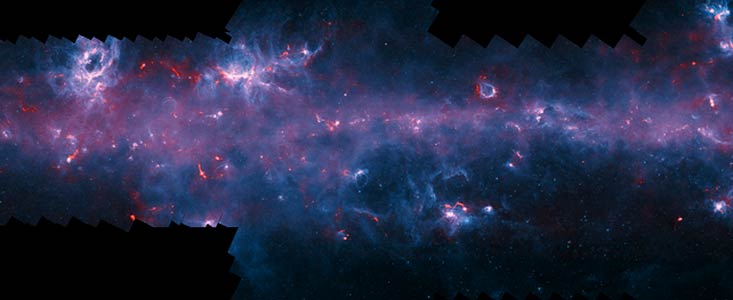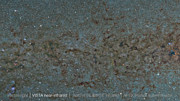Komunikat prasowy
Ukończono ATLASGAL – przegląd Drogi Mlecznej
24 lutego 2016

Aby uczcić ukończenie przeglądu nieba APEX Telescope Large Area Survey of the Galaxy (ATLASGAL), opublikowano nowy, spektakularny obraz Drogi Mlecznej. Teleskop APEX w Chile wykonał mapę całego obszaru płaszczyzny Galaktyki widocznego z południowej półkuli. Dokonał tego po raz pierwszy na falach submilimetrowych – pomiędzy zakresem podczerwonym, a falami radiowymi – i dokładniej niż najnowsze przeglądy za pomocą instrumentów pracujących w przestrzeni kosmicznej. Pionierski 12-metrowy teleskop APEX pozwala astronomom na badania zimnego Wszechświata: gazu i pyłu o temperaturze zaledwie kilkudziesięciu stopni powyżej zera absolutnego.
APEX, Atacama Pathfinder EXperiment, to teleskop położony 5100 metrów nad poziomem morza na płaskowyżu Chajnantor w chilijskim regionie Atacama. Przegląd ATLASGAL wykorzystuje unikatowe charakterystyki teleskopu, aby dostarczyć szczegółowego widoku rozmieszczenia zimnego, gęstego gazu wzdłuż płaszczyzny Drogi Mlecznej [1]. Nowe zdjęcie obejmuje większość obszarów powstawania gwiazd w południowej Drodze Mlecznej [2].
Nowe mapy ATLASGAL pokrywają obszar na niebo długi na 140 stopni i szeroki na 3 stopnie, czterokrotnie większy niż pierwsza publikacja danych ATLASGAL [3]. Nowe mapy mają także lepszą jakość, ponieważ niektóre obszary były obserwowane ponownie w celu uzyskania bardziej danych o bardziej spójnej jakości na całym badanych obszarze.
Przegląd ATLASGAL jest najbardziej udanych spośród dużych programów APEX z prawie 70 powiązanymi z nim publikacjami naukowymi, a jego dziedzictwo będzie się rozszerzać jeszcze bardziej, ponieważ całej społeczności astronomicznej udostępniono wszystkie zredukowane dane [4].
W sercu APEX znajdują się jego czułe instrumenty. Jeden z nich, LABOCA (the LArge BOlometer Camera) był używany podczas przeglądu ATLASGAL. LABOCA mierzy przychodzące promieniowanie poprzez rejestrację niewielkiego wzrostu temperatury, który ono wywołuje na detektorach i może wykryć emisję od ciemnych, zimnych pasm pyłu przesłaniających światło gwiazdowe.
Nowa publikacja ATLASGAL uzupełnia obserwacje z należącego do ESA satelity Planck [5]. Połączenie danych Plancka z APEX pozwoliło astronomom na wykrycie emisji rozciągającej się na większym obszarze nieba i oszacowanie z niego ilości gęstego gazu w wewnętrznych częściach Galaktyki. Dane ATLASGAL zostały także użyte do utworzenia kompletnego przeglądu zimnych i masywnych obłoków, w których formują się nowe generacje gwiazd.
„ATLASGAL dostarcza ciekawego wglądu w miejsca, gdzie powstają następne pokolenia masywnych gwiazd i gromad. Łącząc te obserwacje z danymi z Plancka, możemy uzyskać nawiązanie do wielkoskalowych struktur olbrzymich obłoków molekularnych” wskazuje Timea Csengeri z Max Planck Institute for Radio Astronomy (MPIfR), Bonn, Niemcy, która kierowała pracami związanymi z łączeniem danych APEX i Plancka.
Teleskop APEX niedawno świętował dziesięć lat udanych badań zimnego Wszechświata. Odgrywa ważną rolę nie tylko jako pionier, ale także jako urządzenie komplementarne dla ALMA, Atacama Large Millimeter/submillimeter Array, sieci radioteleskopów umiejscowionej na płaskowyżu Chajnantor. APEX jest prototypową anteną skonstruowaną dla projektu ALMA i znalazł wiele obiektów, które ALMA może badać bardziej szczegółowo.
Leonardo Testi z ESO, który jest członkiem zespołu ATLASGAL i Europejskim Naukowcem Projektu w ALMA, podsumowuje: „ATLASGAL pozwolił nam uzyskać nowy, mający znaczenie widok na gęsty ośrodek międzygwiazdowy naszej własnej galaktyki, Drogi Mlecznej. Nowa publikacja pełnego przeglądu otwiera możliwość przeszukiwania tego niesamowitego zestawu danych w celu kolejnych odkryć. Wiele zespołów naukowców już korzystało z danych ATLASGAL do planowania szczegółowych obserwacji za pomocą ALMA.”
Uwagi
[1] Mapa została skonstruowana z indywidualnych obserwacji APEX promieniowania o długości 870 µm (0,87 milimetra).
[2] Mapa północnej części Drogi Mlecznej została już wykonana za pomocą James Clerk Maxwell Telescope (JCMT) i innych teleskopów, ale niebo południowe jest szczególnie ważne, ponieważ widać tutaj centrum Galaktyki i ponieważ jest dostępne dla dalszych, dokładnych obserwacji za pomocą ALMA.
[3] Pierwszy opublikowany zestaw danych pokrywa obszar około 95 stopni kwadratowych, bardzo długi i wąski pasek wzdłuż płaszczyzny Galaktyki, szeroki na dwa stopnie i długi na 40 stopni. Finalna mapa będzie pokrywać 420 stopni kwadratowych, czyli ponad cztery razy więcej.
[4] Produkty z danymi są dostępne poprzez archiwum ESO.
[5] Dane z Plancka pokrywają całe niebo, ale z kiepską przestrzenną zdolnością rozdzielczą. ATLASGAL pokrywa tylko płaszczyznę Galaktyki, ale z dużą kątową rozdzielczością. Połączenie obu przeglądów daje świetny dynamiczny zasięg przestrzenny.
Więcej informacji
ATLASGAL jest efektem współpracy pomiędzy Max Planck Institute for Radio Astronomy (MPIfR), Max Planck Institute for Astronomy (MPIA), ESO oraz University of Chile.
APEX to projekt współpracy pomiędzy Max Planck Institute for Radio Astronomy (MPIfR), Onsala Space Observatory (OSO) oraz ESO. Użytkowanie APEX na Chajnantor zostało powierzone ESO.
ALMA jest partnerstwem pomiędzy ESO, amerykańską National Science Foundation (NSF) i National Institutes of Natural Sciences (NINS) of Japan, we współpracy z Chile. ALMA jest finansowana przez ESO w imieniu Krajów Członkowskich, przez NSF we współpracy z National Research Council of Canada (NRC) oraz przez National Science Council of Taiwan (NSC) i NINS we współpracy Academia Sinica (AS) na Tajwanie oraz przez Korea Astronomy and Space Science Institute (KASI).
ESO jest wiodącą międzyrządową organizacją astronomiczną w Europie i najbardziej produktywnym obserwatorium astronomicznym na świecie. Wspiera je 16 krajów: Austria, Belgia, Brazylia, Czechy, Dania, Finlandia, Francja, Hiszpania, Holandia, Niemcy, Polska, Portugalia, Szwajcaria, Szwecja, Wielka Brytania oraz Włochy. ESO prowadzi ambitne programy dotyczące projektowania, konstrukcji i użytkowania silnych naziemnych instrumentów obserwacyjnych, pozwalając astronomom na dokonywanie znaczących odkryć naukowych. ESO odgrywa wiodącą rolę w promowaniu i organizowaniu współpracy w badaniach astronomicznych. ESO zarządza trzema unikalnymi, światowej klasy obserwatoriami w Chile: La Silla, Paranal i Chajnantor. W Paranal ESO posiada teleskop VLT (Very Large Telescope - Bardzo Duży Teleskop), najbardziej zaawansowane na świecie astronomiczne obserwatorium w świetle widzialnym oraz dwa teleskopy do przeglądów. VISTA pracuje w podczerwieni i jest największym na świecie instrumentem do przeglądów nieba, natomiast VLT Survey Telescope to największy teleskop dedykowany przeglądom nieba wyłącznie w zakresie widzialnym. ESO jest głównym partnerem ALMA, największego istniejącego projektu astronomicznego. Z kolei na Cerro Armazones, niedaleko Paranal, ESO buduje 39-metrowy teleskop E-ELT (European Extremely Large Telescope - Ekstremalnie Wielki Teleskop Europejski), który stanie się “największym okiem świata na niebo”.
Linki
- Max-Planck-Institute for Radio Astronomy (MPIfR)
- Onsala Space Observatory (OSO)
- ATLASGAL informacje w MPIfR
- Csengeri et al. 2016 - publikacja na temat połaczenia z danymi z Plancka
- Publikacje zwiazane z ATLASGAL w ESO Telescope Bibliography
Kontakt
Carlos De Breuck
ESO APEX Programme Scientist
Garching bei München, Germany
Tel.: +49 89 3200 6613
E-mail: cdebreuc@eso.org
Frederic Schuller
ATLASGAL Principal Investigator - Max Planck Institute for Radio Astronomy
Bonn, Germany
E-mail: fschulle@apex-telescope.org
Friedrich Wyrowski
APEX Project Scientist – Max Planck Institute for Radio Astronomy
Bonn, Germany
Tel.: +49 228 525 383
E-mail: fwyrowski@mpifr-bonn.mpg.de
Norbert Junkes
Press and Public Outreach – Max Planck Institute for Radio Astronomy
Bonn, Germany
Tel.: +49 228 525 399
E-mail: njunkes@mpifr-bonn.mpg.de
Richard Hook
ESO Public Information Officer
Garching bei München, Germany
Tel.: +49 89 3200 6655
Tel. kom.: +49 151 1537 3591
E-mail: rhook@eso.org
Krzysztof Czart (Kontakt dla mediów Polska)
Sieć Popularyzacji Nauki ESO
oraz Urania - Postępy Astronomii
Toruń, Polska
Tel.: +48 513 733 282
E-mail: eson-poland@eso.org
O komunikacie
| Komunikat nr: | eso1606pl |
| Nazwa: | Milky Way |
| Typ: | Milky Way |
| Facility: | Atacama Pathfinder Experiment |
| Instrumenty: | LABOCA |
Po angielsku









